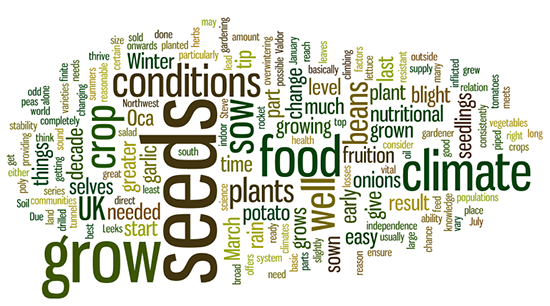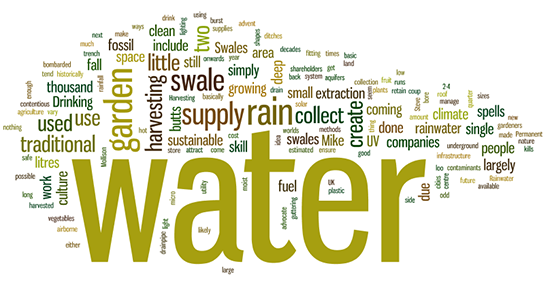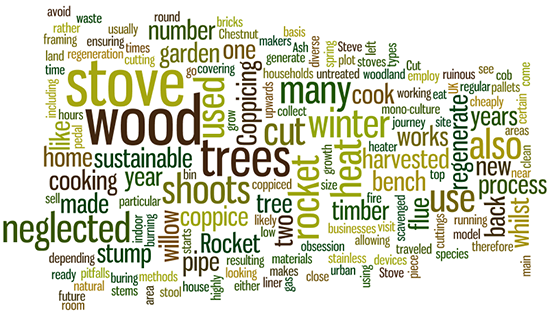Consumerism and the Neoliberal ideology that perpetuates this mindless and wasteful way of living does not only have a detrimental effect on the earths ecology and all flora and fauna living on the planet, it also effects a number of vital human elements including our health and well being, our knowledge of how to do human things such as growing our own food and feeding our selves, providing our own medicines, providing our own heat and shelter. To put it in a very basic and direct manner, consumer capitalism has created redundant human beings in terms of people being resourceful and having the traditional skills that out ancestor had.
Why do we need to know traditional skills?
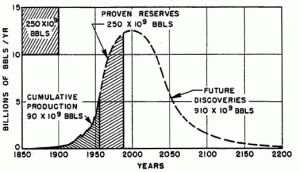 The fossil fuels that have created our busy and dynamic world are finite and the demand for them every increasing with every passing year; the service industries that largely supply people with ready to use resources are totally dependant on a cheap a supply of fossil fuels. So by learning traditional skills to generate and prepare our own resources we are effectively removing ourselves from being locked into the fossil fuel powered service industries that have become the stainless steel provider for much of humanity. Whilst we remove ourselves from the fossil fuel locked in effect, we also loosen the reigns that modern employment has on us because we are able to work less due to the fact that we are creating and processing our own human resources without the need to go out and buy them with money we’ve earned through employment.
The fossil fuels that have created our busy and dynamic world are finite and the demand for them every increasing with every passing year; the service industries that largely supply people with ready to use resources are totally dependant on a cheap a supply of fossil fuels. So by learning traditional skills to generate and prepare our own resources we are effectively removing ourselves from being locked into the fossil fuel powered service industries that have become the stainless steel provider for much of humanity. Whilst we remove ourselves from the fossil fuel locked in effect, we also loosen the reigns that modern employment has on us because we are able to work less due to the fact that we are creating and processing our own human resources without the need to go out and buy them with money we’ve earned through employment.
How do we learn traditional skills?
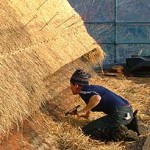 Learning traditional human skills isn’t difficult; the internet is a great source of free information that will provide you with recipes, instructions and guidance on how to up skill for an uncertain future. In the UK a good deal of people from the many global communities that now make up modern Britain will have a good knowledge of traditional human skills, and its worthwhile looking at community notice boards and websites for any skills sessions that might be running in different communities. People from different global communities will not have been so subjected to consumer capitalism and the service industries that have taken over that which we would have previously made our selves. If you want to learn these skills directly it is certainly worth speaking to anyone who is in their 50s or sixties as they would have a variety of different skills which they would have learned before the age of consumerism and the service industries, a great reference points when speaking to older people is the Dig for Victory campaigns that happened during the second world war where all households grew as much food as possible in their yards and gardens, and it is this mind set that we seek to develop in our modern and wasteful age.
Learning traditional human skills isn’t difficult; the internet is a great source of free information that will provide you with recipes, instructions and guidance on how to up skill for an uncertain future. In the UK a good deal of people from the many global communities that now make up modern Britain will have a good knowledge of traditional human skills, and its worthwhile looking at community notice boards and websites for any skills sessions that might be running in different communities. People from different global communities will not have been so subjected to consumer capitalism and the service industries that have taken over that which we would have previously made our selves. If you want to learn these skills directly it is certainly worth speaking to anyone who is in their 50s or sixties as they would have a variety of different skills which they would have learned before the age of consumerism and the service industries, a great reference points when speaking to older people is the Dig for Victory campaigns that happened during the second world war where all households grew as much food as possible in their yards and gardens, and it is this mind set that we seek to develop in our modern and wasteful age.
Traditional skills for a future world
Traditional skills and their proliferation are a must in times of dwindling energy supplies and economic uncertainty, anything that is produced, grown or made by the community within the community is both low impact and economically empowering for those who engage in this local production. A failure to learn traditional skills in an uncertain future could leave us without food and other vital resources, the stainless steel provider of the service industries providing us with ready prepared resources is on the way out.
Grow your own food!
We begin this series by looking at our vital needs, first and foremost is our ability to feed our selves. During the last decade there has been crop failures in various parts of the world that are a direct result of our changing climate, on top of this, all of the ‘easy to get at’ oil has been drilled, piped, sold and used. If we consider just these two factors alone when we think about our food supply, it really is based on a precarious and finite situation that offers no real stability to populations and no long term sound ecology to the land on which our food is grown. When we grow our own food we are providing our selves, families and communities with independence from the system, local resilience and a greater level of nutritional value.
How do you grow food?
 Gardening isn’t rocket science, most things are fairly easy to grow once the right conditions are in place for your plants to thrive, the conditions needed to grow food in all climates are basically the same conditions needed for all plants to grow and function to fruition:
Gardening isn’t rocket science, most things are fairly easy to grow once the right conditions are in place for your plants to thrive, the conditions needed to grow food in all climates are basically the same conditions needed for all plants to grow and function to fruition:
- Viable seeds suited to your soil and climate
- Soil that meets the nutritional requirements of the seeds
- Enough sunlight and rain to ensure that you crops reach fruition
- Seasonal knowledge of when to plant and sow certain seeds
- Some basic tools
When to sow seeds?
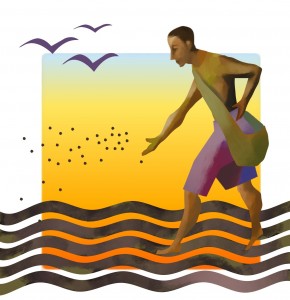 A great many seeds are sown from March onwards in the UK, there are few exceptions when growing overwintering garlic, onions and some of the hardier varieties of lettuce such as Winter Density and Valdor. Winter vegetables such as Leeks and the Brassica family can be sown throughout much of the summer usually until the end of July in some cases. One tip I can give as regards the time to sow seeds is in relation to growing tomatoes and capsicum, start their seeds off early such as mid January on a south facing indoor space, this means that by time these plants are ready to be either planted on outside or in a poly tunnel that they will have a good size and level of health, which will lead onto a greater crop than seeds started in March.
A great many seeds are sown from March onwards in the UK, there are few exceptions when growing overwintering garlic, onions and some of the hardier varieties of lettuce such as Winter Density and Valdor. Winter vegetables such as Leeks and the Brassica family can be sown throughout much of the summer usually until the end of July in some cases. One tip I can give as regards the time to sow seeds is in relation to growing tomatoes and capsicum, start their seeds off early such as mid January on a south facing indoor space, this means that by time these plants are ready to be either planted on outside or in a poly tunnel that they will have a good size and level of health, which will lead onto a greater crop than seeds started in March.
What grows well in climate change Britain?
During the odd summers of the best part of the last decade, the things that have consistently grown well for us have been beans and peas, particularly broad beans and climbing beans, onions and garlic have also done well and much of the salad leaves and herbs we grew. What you can grow in your part of the UK may vary slightly to what I can grow in the Northwest, one tip I would certainly give when climate change gardening is to sow more seeds than you need, at least you are in with a chance of getting a reasonable crop if you have more seedlings, and start your seedlings off as early as possible within reason. Due to the large amount of rain in 2012 the conditions for potato blight have been perfect, which as a result has inflicted heavy losses on the the UK potato crop, there is a plant similar to potatoes called Oca from South America, Oca grows well in our climate and is completely blight resistant.
Water harvesting
It might seem a little odd to include water harvesting as a traditional skill, but we have only have piped water from the last quarter on the 19th century onwards, so it seems fitting to include water harvesting as a traditional skill. It is estimated that only around 2-4% of the worlds water is clean enough to drink, this amount is likely to fall during the coming decades due to the expansion of modern agriculture and fossil fuel extraction methods, and with the remainder of our water supply in the hands of Private shareholders and utility companies infrastructure work to ensure future supplies of fresh water isn’t being done, the work that is being carried out is largely cosmetic, such as repairing a some of the burst pipes in our town and cities, but largely there is very little being done by these companies to create a sustainable and ecologically friendly water supply for the coming generations. There are ways that we can manage our own water supply which are sustainable, cost next to nothing, and make full use of the millions of gallons of rain that fall onto us every year. Harvesting rain water is not a new thing, before the advent of fossil fuel culture people from all cultures have made use of rainwater, we have only stopped because of its mass extraction from bore holes and aquifers.
Swales to Keep your garden moist and healthy
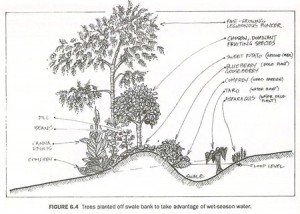 Swales are basically water harvesting ditches, their use has been popularised by Permaculture practitioners such as Bill Mollison, David Holmgren and Geoff Lawton, in nature swales are low pieces of land that attract and retain water. To create a very basic small garden swale simply dig a long trench through the centre of your growing area about a foot deep, when it rains the water will fill the swale and it will be slowly dispersed into the soil on either side of it, this water is then underground and available to the fruit and vegetables that are in your growing area. This means that during dry spells your plants still have some access to water due to the water harvested from your mini swale. The design of swales will vary from space to space and climate to climate, so it is worthwhile researching a little before you create your own swale.
Swales are basically water harvesting ditches, their use has been popularised by Permaculture practitioners such as Bill Mollison, David Holmgren and Geoff Lawton, in nature swales are low pieces of land that attract and retain water. To create a very basic small garden swale simply dig a long trench through the centre of your growing area about a foot deep, when it rains the water will fill the swale and it will be slowly dispersed into the soil on either side of it, this water is then underground and available to the fruit and vegetables that are in your growing area. This means that during dry spells your plants still have some access to water due to the water harvested from your mini swale. The design of swales will vary from space to space and climate to climate, so it is worthwhile researching a little before you create your own swale.
Rainwater collection
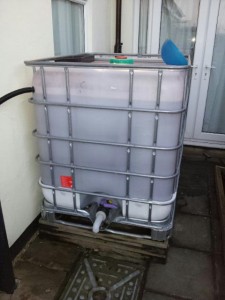 Most gardeners tend to have a water butt in their garden, these plastic butts are simply connected to the drain pipe that runs down from the guttering of the roof of your home. Water butts come in different shapes and sizes and can collect and store anything from a hundred to two thousands litres. In a single night of good rainfall in the UK it is possible to collect a thousand litres of water from a single drainpipe. Both myself and Mike at Permanent culture now both collect rain water in our respective homes, Mike has two large thousand litre tanks which are used to water his garden and flush the loo with, I have two smaller containers where the water is used on our back garden during hot spells, it is also used to clean out the chicken coup, this water is then added to the composter.
Most gardeners tend to have a water butt in their garden, these plastic butts are simply connected to the drain pipe that runs down from the guttering of the roof of your home. Water butts come in different shapes and sizes and can collect and store anything from a hundred to two thousands litres. In a single night of good rainfall in the UK it is possible to collect a thousand litres of water from a single drainpipe. Both myself and Mike at Permanent culture now both collect rain water in our respective homes, Mike has two large thousand litre tanks which are used to water his garden and flush the loo with, I have two smaller containers where the water is used on our back garden during hot spells, it is also used to clean out the chicken coup, this water is then added to the composter.
Drinking rainwater?
Drinking rain water is contentious issue, some people advocate using intricate filteration systems where the water is bombarded with UV light, which kills off micro-organisms, whilst others stick with the traditional line that our only safe water supply historically has been rain water and water from deep wells. Since we live in times where these is still much in the way of airborne contaminants it would certainly be a safer idea to get hold of the micro filters and rig yourself up a UV lighting system attached to a small solar panel.
Providing your owns source of heat
In any low impact future that would like to see it is highly likely that the types of materials that we use to generate heat and the methods we employ will have to be very diverse to avoid the ruinous pitfalls of our obsession with mono-culture. In this particular piece I will be looking at using wood as a sustainable resource to be used to heat and cook with as all of our sources of wood are either coppiced from neglected woods near by, or collected as waste from various businesses in the local area, therefore I am offering here a sustainable model that works for us.
Fuel
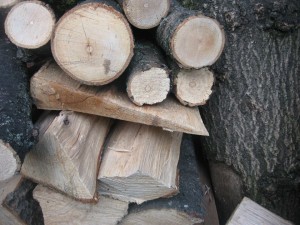 We have a wood burning stove the heats our home up, once a year during the winter time we go down to a neglected woodland close to where we live and coppice timber from the site. We also visit a furniture makers and picture framing company during the winter who allow us to collect their off cuts of clean untreated wood. Other scavenged urban timber comes from broken pallets that we regularly find whilst out and about around Bolton.
We have a wood burning stove the heats our home up, once a year during the winter time we go down to a neglected woodland close to where we live and coppice timber from the site. We also visit a furniture makers and picture framing company during the winter who allow us to collect their off cuts of clean untreated wood. Other scavenged urban timber comes from broken pallets that we regularly find whilst out and about around Bolton.
Coppicing
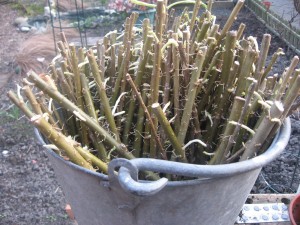 Coppicing is the process of cutting trees down, allowing the stumps to regenerate for a number of years (usually 7 – 25) and then harvesting the resulting stems. It makes use of the natural regeneration properties of many tree species, including Oak, Hazel, Maple, Sweet Chestnut, Lime and Ash. Cut such trees down and they will regenerate from the cut stump, producing many new shoots, rather than a single main stem. The cut tree stump is known as a stool and the shoots, depending on their harvested size, as rods, poles or logs. The shoots are harvested on a rotational cycle. This means that they are left to grow for a certain number of years and are then cut, where upon the whole process starts again. I coppice willow cuttings every year from trees on my allotment plot, some are used to re-plant new willow on neglected areas of land and some I sell on cheaply as a way of ensuring the spread and growth of trees.
Coppicing is the process of cutting trees down, allowing the stumps to regenerate for a number of years (usually 7 – 25) and then harvesting the resulting stems. It makes use of the natural regeneration properties of many tree species, including Oak, Hazel, Maple, Sweet Chestnut, Lime and Ash. Cut such trees down and they will regenerate from the cut stump, producing many new shoots, rather than a single main stem. The cut tree stump is known as a stool and the shoots, depending on their harvested size, as rods, poles or logs. The shoots are harvested on a rotational cycle. This means that they are left to grow for a certain number of years and are then cut, where upon the whole process starts again. I coppice willow cuttings every year from trees on my allotment plot, some are used to re-plant new willow on neglected areas of land and some I sell on cheaply as a way of ensuring the spread and growth of trees.
Heating and cooking devices
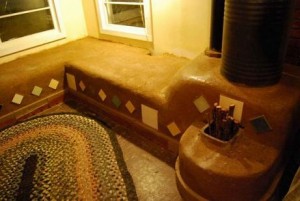 At home we have a standard gas cooker like many other households in the UK, but we also use our wood burning stove to cook on during the winter, you stick a casserole onto top of the stove and when you come back to it in two hours times it is cooked and ready to eat. In our back garden there are two rocket stoves, one heavy duty made from fire and house bricks and one that is made from a stainless steel pedal bin liner. During the spring and summer both Rocket Stoves are used on a very regular basis for cooking on whilst we are working in the garden. There is a also an indoor rocket stove innovation called the ‘Rocket Stove mass heater’ this works by running a flue pipe round the edge of the room, covering it with a cob bench and capturing the heat in the bench from the rocket stove that has travelled through the flue pipe on its journey upwards.
At home we have a standard gas cooker like many other households in the UK, but we also use our wood burning stove to cook on during the winter, you stick a casserole onto top of the stove and when you come back to it in two hours times it is cooked and ready to eat. In our back garden there are two rocket stoves, one heavy duty made from fire and house bricks and one that is made from a stainless steel pedal bin liner. During the spring and summer both Rocket Stoves are used on a very regular basis for cooking on whilst we are working in the garden. There is a also an indoor rocket stove innovation called the ‘Rocket Stove mass heater’ this works by running a flue pipe round the edge of the room, covering it with a cob bench and capturing the heat in the bench from the rocket stove that has travelled through the flue pipe on its journey upwards.


